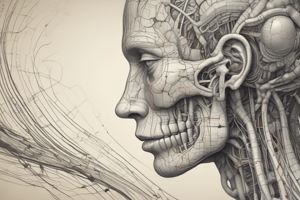Podcast
Questions and Answers
Which cranial nerve is responsible for the sense of smell?
Which cranial nerve is responsible for the sense of smell?
- Cranial nerve 1 (correct)
- Cranial nerve 5
- Cranial nerve 2
- Cranial nerve 7
Which cranial nerve is responsible for controlling pupil response and other motions of the eye?
Which cranial nerve is responsible for controlling pupil response and other motions of the eye?
- Cranial nerve 2
- Cranial nerve 3 (correct)
- Cranial nerve 4
- Cranial nerve 6
Which cranial nerve is responsible for transmitting sensation from the scalp, teeth, jaw, and face to the brain?
Which cranial nerve is responsible for transmitting sensation from the scalp, teeth, jaw, and face to the brain?
- Cranial nerve 9
- Cranial nerve 7
- Cranial nerve 10
- Cranial nerve 5 (correct)
Which cranial nerve is responsible for facilitating balance and hearing?
Which cranial nerve is responsible for facilitating balance and hearing?
Which cranial nerve is responsible for supplying motor activity to the tongue?
Which cranial nerve is responsible for supplying motor activity to the tongue?
Which cranial nerve is responsible for controlling motor activity in the heart, throat, and digestive system?
Which cranial nerve is responsible for controlling motor activity in the heart, throat, and digestive system?
Which cranial nerve is responsible for transmitting sensation from the sinuses to the brain?
Which cranial nerve is responsible for transmitting sensation from the sinuses to the brain?
Which part of the brainstem does the oculomotor nerve emerge from?
Which part of the brainstem does the oculomotor nerve emerge from?
What is the function of the trochlear nerve?
What is the function of the trochlear nerve?
Which cranial nerve has both sensory and motor functions?
Which cranial nerve has both sensory and motor functions?
Where does the abducens nerve innervate?
Where does the abducens nerve innervate?
What is the function of the vagus nerve?
What is the function of the vagus nerve?
Where does the glossopharyngeal nerve allow taste and ear movement?
Where does the glossopharyngeal nerve allow taste and ear movement?
What is the function of the accessory nerve?
What is the function of the accessory nerve?
Which cranial nerve emerges from the back of the midbrain part of the brainstem?
Which cranial nerve emerges from the back of the midbrain part of the brainstem?
Flashcards are hidden until you start studying
Study Notes
Cranial Nerves
- Cranial nerve 1 (Olfactory nerve) is responsible for the sense of smell.
Vision and Eye Movement
- Cranial nerve 2 (Optic nerve) governs eyesight.
- Cranial nerve 3 (Oculomotor nerve) controls pupil response and other eye movements, originating from the brainstem where the midbrain meets the pons.
- Cranial nerve 4 (Trochlear nerve) controls eye muscles, emerging from the back of the midbrain part of the brainstem.
- Cranial nerve 6 (Abducens nerve) innervates some eye muscles.
Face, Head, and Neck Functions
- Cranial nerve 5 (Trigeminal nerve) is the largest and most complex cranial nerve, with both sensory and motor functions, conveying sensation from the scalp, teeth, jaw, sinuses, and parts of the mouth and face to the brain, and enabling chewing muscles.
- Cranial nerve 7 (Facial nerve) supports face movement, taste, and glandular functions.
- Cranial nerve 11 (Accessory nerve) innervates specific muscles in the head, neck, and shoulder.
Hearing, Balance, and Digestion
- Cranial nerve 8 (Vestibulocochlear nerve) facilitates balance and hearing.
- Cranial nerve 9 (Glossopharyngeal nerve) enables taste, ear and throat movement, and has many more functions.
- Cranial nerve 10 (Vagus nerve) allows sensation around the ear and digestive system, and controls motor activity in the heart, throat, and digestive system.
Tongue Movement
- Cranial nerve 12 (Hypoglossal nerve) supplies motor activity to the tongue.
Cranial Nerves
- Cranial nerve 1 (Olfactory nerve) is responsible for the sense of smell.
Vision and Eye Movement
- Cranial nerve 2 (Optic nerve) governs eyesight.
- Cranial nerve 3 (Oculomotor nerve) controls pupil response and other eye movements, originating from the brainstem where the midbrain meets the pons.
- Cranial nerve 4 (Trochlear nerve) controls eye muscles, emerging from the back of the midbrain part of the brainstem.
- Cranial nerve 6 (Abducens nerve) innervates some eye muscles.
Face, Head, and Neck Functions
- Cranial nerve 5 (Trigeminal nerve) is the largest and most complex cranial nerve, with both sensory and motor functions, conveying sensation from the scalp, teeth, jaw, sinuses, and parts of the mouth and face to the brain, and enabling chewing muscles.
- Cranial nerve 7 (Facial nerve) supports face movement, taste, and glandular functions.
- Cranial nerve 11 (Accessory nerve) innervates specific muscles in the head, neck, and shoulder.
Hearing, Balance, and Digestion
- Cranial nerve 8 (Vestibulocochlear nerve) facilitates balance and hearing.
- Cranial nerve 9 (Glossopharyngeal nerve) enables taste, ear and throat movement, and has many more functions.
- Cranial nerve 10 (Vagus nerve) allows sensation around the ear and digestive system, and controls motor activity in the heart, throat, and digestive system.
Tongue Movement
- Cranial nerve 12 (Hypoglossal nerve) supplies motor activity to the tongue.
Studying That Suits You
Use AI to generate personalized quizzes and flashcards to suit your learning preferences.




